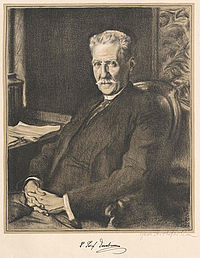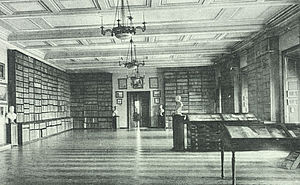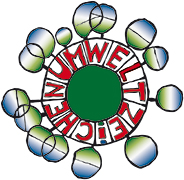1920: The Court Library Becomes the National Library

Upon the fall of the Danube Monarchy, the court library had lost its legal entity. The collections, which had hitherto been regarded as the emperor’s private property, passed into the possession of the Republic. The fideicommissum library, the Habsburgs’ private family library, was also incorporated into the National Library, but to this day has been kept in a separate place, i.e. in the portrait collection, in its entirety.
After lengthy discussions about the future name of the former imperial court library, a proposal made by prefect Josef Donabaum (1917–1922) was accepted: "National Library". It was impossible then to speak of an "Austrian" National Library, since it was assumed that there was no such thing as an Austrian nation. Donabaum’s explanatory statement, pointed out in an official letter of 28 June 1920, typically reflects the political mind-set of those days:
"All of these considerations prompt the management to suggest the title ‘National Library’. Certainly, several objections have been made against it, and some library officials have pointed out that an ‘Austrian nation’ did not exist, and that this name could even prevent a future annexation to Germany.
However, such conclusions and anxieties appear to be too far-fetched. That an Austrian nation in its own right does not exist can be assumed to be a fact known around the world. To this day, no one has complained that the German National Museum in Nuremberg exists next to a Bavarian National Museum in Munich. But then – and this is very important – the term ‘National Library’ also encompasses the very duty the library will have to fulfil in the future" (Geschichte der Österreichischen Nationalbibliothek, vol. I, pp. 617/18, file HB 350/1920).

After the collapse of the monarchy, national identity was not sought in Austria, but in Germany. Prefect Josef Donabaum explicitly identified the National Library’s new function as being a “meeting point for the national literature of those German groups that have now come to be under foreign national rule”.
Due to the library’s great shortage of space, Donabaum vigorously sought approval for his plans of spatial expansion. In 1919 the so-called “Second Depot” underneath the State Hall was assigned to the library. The Papyrus Museum and its collection and the music collection found a new home on the second floor of the Albertina building (the “Palais Friedrich”). The collection of engravings was separated from the library and merged with that of the Albertina’s collection of prints and drawings.
In 1921, the portrait collection (including the fideicommissum library) and the theatre collection were established.
» 1934: The National Library in the Corporate State

